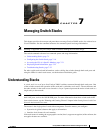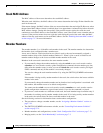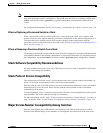
7-6
Catalyst 2960 and 2960-S Switch Software Configuration Guide
OL-8603-09
Chapter 7 Managing Switch Stacks
Understanding Stacks
Stack MAC Address
The MAC address of the master determines the stack MAC address.
When the stack initializes, the MAC address of the master determines the bridge ID that identifies the
stack in the network.
If the master changes, the MAC address of the new master determines the new bridge ID. However, when
the persistent MAC address feature is enabled, there is an approximate 4-minute delay before the stack
MAC address changes. During this time period, if the previous master rejoins the stack, the stack
continues to use its MAC address as the stack MAC address, even if the switch is now a member and not
a master. If the previous master does not rejoin the stack during this period, the stack takes the MAC
address of the new stack master as the stack MAC address. See the “Enabling Persistent MAC Address”
section on page 7-17 for more information.
Member Numbers
The member number (1 to 4) identifies each member in the stack. The member number also determines
the interface-level configuration that a member uses.
A new, out-of-the-box switch (one that has not joined a stack or has not been manually assigned a
member number) ships with a default member number of 1. When it joins a stack, its default stack
member number changes to the lowest available member number in the stack.
Members in the same stack cannot have the same member number.
• If you manually change the member number by using the switch current-stack-member-number
renumber new-stack-member-number global configuration command, the new number goes into
effect after that member resets (or after you use the reload slot stack-member-number privileged
EXEC command) and only if that number is not already changed.
You can also change the stack member number is by using the SWITCH_NUMBER environment
variable.
If the number is being used by another member in the stack, the switch selects the lowest available
number in the stack.
If you manually change the member number and no interface-level configuration is associated with
that number, that member resets to its default configuration.
You cannot use the switch current-stack-member-number renumber new-stack-member-number
global configuration command on a provisioned switch. If you do, the command is rejected.
• If you move a stack member to a different switch stack, the stack member keeps its number only if
the number is not being used by another member in the stack. If it is being used by another member
in the stack, the switch selects the lowest available number in the stack.
See the following sections for information about stack member configuration:
• The procedure to change a member number, see the “Assigning a Member Number” section on
page 7-19.
• The SWITCH_NUMBER environment variable, see the “Controlling Environment Variables”
section on page 3-21.
• Member numbers and configurations, see the “Stack Configuration Files” section on page 7-13.
• Merging stacks, see the “Stack Membership” section on page 7-3.


















